Did you know the global car rental market is expected to hit $272 billion by 2030?
That’s a lot of opportunity, and it’s all fueled by convenience and smart tech. This makes now the perfect time to build a car rental app. With features like easy bookings and real-time updates, you can create a service people love and trust.
If you can create a seamless, intuitive app that makes renting a car as easy as booking a ride, you'll have the upper hand in a booming market.
But here’s the real secret: building a successful car rental app isn’t just about tech—it’s about creating an unforgettable experience for your users. From seamless bookings to reliable location tracking, every detail matters. This complete car rental app development guide will show you exactly how to build an app that stands out from the competition. Ready to dive in? Let’s break it down and get you on the road to building an app that not only works but wins.
What is a Car Rental App?
A car rental app is a platform that allows users to rent vehicles for short-term use directly from their smartphones. These apps provide a convenient way of renting vehicles by providing unique features like real-time tracking of vehicle availability, easy payments, and fast booking options.
Now, without in-person interactions, car rental apps provide a more convenient and flexible solution for those looking to rent cars. Whether it's for business or leisure, car rental apps provide their service to users who prefer convenience in travel and a smooth experience.
How Car Rental Apps Work?
Car rental apps make it easier for users to rent a car in just a few steps:
-
- Sign-Up/Log-In: Users create an account to get started.
- Search & Filter: Users can search for available cars based on location, type, and rental duration. The app shows only real-time availability to ensure a smooth experience.
- Booking & Payment: After selecting a vehicle, users can book it and pay via the in-app payment system.
- Pick-Up & Return: Once booked, users are informed about pick-up instructions. Many apps integrate GPS navigation to help users navigate their way.
For companies looking to create a car rental app, knowing how such app works can be really helpful.
Examples of Popular Car Rental Apps
Several apps have become popular in the car rental space:
-
-
Turo: A peer-to-peer car rental app that allows users to rent cars directly from owners, offering a unique selection of vehicles like SUVs or exotic cars.
-
Zipcar: This app provides self-drive car rentals with flexible hourly and daily rates, making it ideal for urban mobility.
-
Getaround: A peer-to-peer rental service where users can rent cars by the hour, providing ultimate flexibility and convenience.
-
These apps show the evolution of the car rental industry and highlight how businesses can build a car rental app to cater to modern users.
Why is a Car Rental App a Profitable Business Idea?
The car rental app idea is emerging as a highly profitable business idea due to the rapid growth in urban mobility, increasing demand for convenience, and shifting travel preferences.
As more users are shifting towards digital solutions, car rental apps provide an efficient and cost-effective alternative to traditional rental services.
1. Growth in Urban Mobility and Car-Sharing Trends
The demand for car-sharing services has grown significantly in urban areas, where the need for flexible transportation is at an all-time high. People are looking for convenient options to get around without the responsibilities of car ownership.
-
-
Urbanization: With more people living in cities, there’s an increasing demand for car rental services.
-
Car-sharing models: These services allow users to rent vehicles for short periods, perfect for city dwellers.
-
As a result, developing a car rental app tailored to urban mobility needs taps into a growing market of users looking for flexible transportation solutions.
2. Increased Demand for Convenience in Travel
In today’s fast-paced world, customers demand seamless, convenient services. Car rental apps provide exactly that by offering simple booking processes and real-time availability. Users can easily rent a car for business trips or vacations without any hassle.
-
-
Streamlined Booking Process: Users prefer apps that allow them to book cars effortlessly, with easy payment options.
-
Real-Time Availability: Real-time tracking ensures that users have access to available vehicles when they need them.
-
If you’re looking to create a car rental app, focusing on delivering an easy and convenient travel experience will meet the growing demand for instant services.
3. Cost-Effectiveness for Users Compared to Ownership
Renting a car via an app can be a more affordable option compared to owning one. With rental services, users save money on maintenance, insurance, and other car ownership costs.
Additionally, car rental apps offer flexible rental periods, making them cost-effective for both short-term and long-term needs.
-
-
Lower costs: Users can rent cars without committing to the high expenses of ownership.
-
Flexible pricing models: Offering options like hourly, daily, or weekly rentals appeals to different user needs.
-
By building a car rental app with affordable pricing models, you can attract a large user base seeking cost-effective alternatives to car ownership.
4. Untapped Potential in Emerging Markets
Emerging markets are a goldmine for car rental app developers, as more people in these regions are becoming familiar with mobile technology and the sharing economy.
These markets present a unique opportunity to capture users who have limited access to traditional rental services but are curious about using technology.
-
-
Rising Middle Class: Many emerging markets are seeing an increase in disposable income, leading to greater demand for rental services.
-
Regional Adaptation: Customizing apps to cater to local needs, such as language preferences or vehicle choices, can further boost adoption.
-
By developing a car rental app for emerging markets, businesses can tap into a growing audience that is eager for convenient and affordable rental solutions.
Market Trends and Statistics for Car Rental Apps
The car rental industry has experienced significant transformations driven by evolving market dynamics. Understanding these market statistics is important for businesses aiming to develop a car rental app that meets current demands and anticipates future needs.
► Global Market Size and Projected Growth
The global car rental market was valued at approximately USD 116.34 billion in 2022 and is projected to grow at a compound annual growth rate (CAGR) of 11.2%, reaching USD 272 billion by 2030. (Grand View Research)
Key insights include:
-
-
Market Expansion: The market is expected to reach USD 156.18 billion in 2025, indicating robust growth. (Grand View Research)
-
User Growth: By 2029, the number of users in the car rental market is projected to reach 820 million, with a user penetration rate increasing from 7.7% in 2024 to 10.1% by 2029. (Statista)
-
Revenue Per User: The average revenue per user (ARPU) is expected to amount to USD 167.40 by 2029. (Statista)
-
Increased travel activities and a shift towards flexible transportation solutions drive this growth.
► Regional Insights
Regional variations highlight diverse market dynamics:
-
-
North America: The car rental market is projected to grow by 3.81% from 2024 to 2029, reaching a market volume of USD 43.00 billion by 2029.(Statista)
-
Asia-Pacific: Emerging markets in this region are experiencing rapid adoption of car rental services, driven by urbanization and increased disposable income.
-
These regional trends underscore the importance of localized strategies when creating a car rental app to cater to specific market needs.
► Consumer Preferences and Behavior
Consumer behavior is evolving towards:
-
-
Flexibility: A preference for short-term rentals over long-term commitments.
-
Convenience: Demand for seamless booking experiences via mobile apps.
-
Personalization: Interest in services that offer tailored vehicle options and pricing.
-
Recent surveys further confirm these preferences:
-
-
A survey by GoodFirms found that 53.3% of respondents consider customer service as the deciding factor when selecting a car rental service provider. (8 News Now)
-
According to a study published in the International Journal of Scientific and Research Publications, the quality of car rental services significantly impacts customer satisfaction, indicating a strong preference for high-quality service. (Science IJSAR)
-
Integrating these preferences is essential when building a car rental app to enhance user satisfaction and engagement.
► Role of Technology in Shaping the Market
Technological advancements are pivotal in transforming the car rental industry:
-
-
Mobile Integration: Smartphone applications facilitate real-time bookings and vehicle tracking.
-
Data Analytics: Analyzing customer data enables personalized services and dynamic pricing models.
-
IoT and AI: Implementing Internet of Things (IoT) devices and artificial intelligence (AI) enhances vehicle maintenance and customer support.
-
Leading industry giants also emphasize the role of technology:
-
-
Google has highlighted that mobile apps can drive customer loyalty by enhancing convenience, citing increased app usage among millennials. (Search Engine Land)
-
A study by Emarsys found that 42% of consumers demonstrate loyalty by installing their favorite brands' apps, highlighting the importance of mobile applications in fostering customer loyalty. (Emarsys)
-
Incorporating these technologies is crucial when developing a car rental app to stay competitive and meet modern consumer expectations. Businesses aiming to create a car rental app should leverage these insights to develop solutions that align with market demands and regional nuances.
Types of Car Rental Apps
Understanding the different types of car rental apps is essential for developing a strategy to cater to diverse user needs. Below, we explore four key types of car rental apps, their features, and their unique value propositions.
1. Self-Drive Car Rental Apps
A self-drive car rental is a service that allows customers to rent a car for a short period of time and drive it themselves.
Features and Benefits:
-
-
Freedom and Flexibility: Users rent cars and drive themselves, enjoying the independence to plan trips at their convenience.
-
Real-Time Tracking: Apps offer real-time vehicle tracking for safety and transparency.
-
Wide Variety of Vehicles: Customers can choose from a diverse fleet, including budget and luxury options.
-
Examples of Popular Self-Drive Apps:
-
-
Zoomcar: A self-drive car rental app popular for short-term rentals in urban areas.
-
Revv: Known for its doorstep delivery service and flexible pricing.
-
Hertz: A global leader offering self-drive rentals through a user-friendly app.
-
Relevance for Businesses: Developing a self-drive app involves incorporating advanced features like dynamic pricing and GPS tracking. This complete guide to on-demand car rental app development will discuss features in brief.
2. Peer-to-Peer Car Rental Apps
Peer-to-peer car rental apps connect car owners with renters. Owners list their vehicles, set availability, and earn passive income, while renters enjoy unique vehicle options.
Features and Benefits:
For Users:
-
-
Vehicle Variety Access: Access to a wide range of vehicles, including rare and unique models.
-
Benefit: Find the perfect vehicle for any occasion, whether it's a luxury ride or a practical option.
-
Affordable Pricing: Cost-effective rental options with transparent pricing.
-
Benefit: Save money and avoid hidden fees with competitive and clear rental rates.
-
-
-
Vehicle Monetization: Easy listing process for idle vehicles.
-
Benefit: Turn your unused vehicles into a steady stream of income with minimal effort.
-
Availability Control: Flexible scheduling for vehicle availability.
-
Benefit: Manage when and how your vehicle is rented, giving you full control.
-
Examples:
-
-
Turo: A leading app in the peer-to-peer segment, offering an extensive range of vehicles.
-
Getaround: Allows users to rent cars by the hour, emphasizing flexibility.
-
For businesses looking to create a car rental app, peer-to-peer platforms offer significant potential in niche markets.
3. Corporate Car Rental Apps
Corporate car rental apps cater to companies needing transportation solutions for employees. These apps streamline fleet booking, tracking, and invoicing.
Key Features of Corporate Car Rentals:
-
-
Centralized billing and payment systems.
-
Integration with company travel policies.
-
Dedicated customer support for corporate clients.
-
Example:
-
-
Avis Budget Group: Offers tailored business solutions with customizable packages.
-
If you're exploring how to build a car rental app for corporate use, focus on scalable, secure systems for bulk management.
4. Traditional Car Rental Apps with Online Services
Traditional car rental services have shifted online, integrating modern app features.
Online Features Enhancing Traditional Models:
-
-
Easy reservations via mobile apps.
-
Real-time fleet availability updates.
-
Example:
-
-
Enterprise Rent-A-Car: Combines its trusted brand with an intuitive app for online bookings.
-
You can hire dedicated developers to create a specific car rental app that is personalized as per your model.
Key Features to Consider While Developing a Car Rental App
Creating a car rental app needs to include features that focus on the user to make sure that the experience is smooth for customers and that businesses can run their operations easily. This complete guide to making a car rental app covers both basic and advanced features for both the user and manager panels.
A] Customer Panel Features
The customer panel is the primary interface where users interact with the app. Here’s what makes it indispensable:
-
-
User Registration/Login: Easy sign up and login options through email, social media, or phone numbers. This ensures quick onboarding and user retention.
-
Vehicle Search and Filtering: You can make a car rental app that stands out from the rest by adding these features. Whether you're making a simple app or a complex one, focusing on these key features will make it easy for people to use and run smoothly.
-
Real-Time Vehicle Availability Tracking: Users can check vehicle availability in real-time, which is clear, convenient, and avoids the problems of overbooking
-
Booking and Scheduling Options: The app should support flexible booking, allowing customers to schedule rentals by the hour, day, or week. This feature increases user convenience, making the app more appealing.
-
In-App Payment Integration: Multiple secure payment options, including credit cards, digital wallets, and UPI, streamline the transaction process. Features like cost breakdown and refund options build trust.
-
Customer Reviews and Ratings: Users can rate their rental experiences and leave feedback for vehicles or services. These ratings help potential customers make informed choices and enhance app credibility.
-
These features are essential when you create a car rental app to cater to the growing demand for on-demand car rentals.
B] Admin Panel Features
The admin panel is the backbone of operations, helping service providers manage vehicles, bookings, and customer queries efficiently.
-
-
Fleet Management Tools: Keep track of vehicle availability, location, and maintenance schedules to ensure smooth operations.
-
Booking Management System: A centralized system allows admins to view, approve, or modify bookings, ensuring efficient scheduling.
-
Real-Time Analytics and Reporting: Admins can monitor performance metrics like revenue, booking trends, and customer preferences. These insights aid decision-making.
-
Customer Support and Complaint Handling: Integrated support tools enable admins to resolve customer complaints quickly, enhancing user satisfaction.
-
Including these features is vital during development of car rental app, ensuring the app meets business needs effectively. You can hire Android app developers who can efficiently help integrate these features into your personalized car rental app.
C] Advanced Features for Enhanced User Experience
To stand out in a competitive market, your app should include advanced functionalities:
-
-
AI-Powered Recommendations: Machine learning algorithms analyze user preferences to suggest the most suitable vehicles.
-
Dynamic Pricing Models: Adjust rental prices based on demand, location, or peak seasons to optimize revenue.
-
GPS Integration for Navigation: Offer real-time directions to pick-up and drop-off locations, enhancing convenience.
-
Multi-Language and Currency Support: Cater to a global audience by enabling users to interact in their preferred language and currency.
-
By integrating these features, you can build a car rental app that stands out in the market. Whether you aim to develop a basic app or an advanced one, focusing on these key features for car rental app ensures a user-friendly experience and operational efficiency.
Step-by-Step Guide to Develop a Car Rental App
Creating a car rental app involves a combination of market research, strategic planning, technical development, and effective marketing. This guide walks you through every critical step, ensuring you know how to develop a car rental app that meets user expectations and drives revenue.
Step 1: Conducting Market Research
Market research forms the backbone of successful app development. Understanding your target audience, analyzing competitors, and identifying industry trends are essential first steps.
1. Why Market Research Matters
Market research helps pinpoint user needs and identify gaps in existing apps. For example, some users may prefer on-demand car rental app services, while others might value affordability or luxury features.
2. Steps to Conduct Effective Research
-
-
Define your target audience: Are you targeting travelers, urban professionals, or businesses? For example:
-
Travelers might seek short-term rentals.
-
Urban residents could prefer self-drive options for daily commutes.
-
-
Study competitors: Analyze popular apps like Turo, Getaround, and Zipcar. Look at their unique features, pricing, and customer reviews.
-
Leverage market data: Use reliable tools such as Statista or IBISWorld to gather insights into global car rental trends and projections.
-
Effective research not only lays a strong foundation but also helps you craft a business strategy that aligns with market demands.
Step 2: Defining Your Business Model
Your business model dictates the app's functionality, monetization, and target audience. The three most common models include:
1. Business-to-Consumer (B2C)
In this model, your company owns the fleet of vehicles and rents them directly to customers. This approach is popular with traditional rental companies integrating online services.
-
-
Advantages: Full control over pricing, inventory, and quality.
-
Challenges: Requires significant capital to maintain a fleet.
-
2. Peer-to-Peer (P2P)
This model connects car owners with renters, enabling owners to earn income while you earn commissions on each transaction.
-
-
Advantages: Low overhead costs since you don’t own vehicles.
-
Challenges: Requires robust verification systems for owners and renters.
-
3. Business-to-Business (B2B)
Targeting businesses that need vehicles for employee use or logistics.
-
-
Advantages: Consistent revenue through long-term contracts.
-
Challenges: Limited target audience compared to B2C or P2P models.
-
Selecting the right business model ensures your app appeals to its intended users and operates sustainably.
Step 3: Creating Wireframes and Prototypes
Before starting the development, you must design your app's structure and functionality. This stage is important, as this will ensure an intuitive and user-friendly experience.
1. Steps to Create Wireframes
-
- Outline the User Journey: Map out how users will navigate through your app, starting from registration to booking.
- Design Intuitive Layouts: Use simple layouts, as these will make sure that users can easily search for cars, view availability, and complete bookings.
- Use Wireframing Tools: Using tools like Figma or Adobe XD allows you to create interactive prototypes for testing.
2. Key Benefits of Prototyping
-
-
Identifies usability issues early.
-
Provides a visual representation for stakeholders.
-
Saves time during development by reducing revisions.
-
Prototyping is an essential step while developing a car rental app, ensuring your design aligns with user expectations.
Step 4: Developing the App
Once the design is finalized, the phase of development begins. This includes building the front end and back end.
1. Choosing the Right Technology Stack
Your tech stack plays an important role in the app's performance, scalability, and compatibility.
-
-
Front-End Development: Use frameworks like React Native or Flutter for cross-platform apps.
-
Back-End Development: Opt for scalable technologies such as Node.js or Django.
-
Database Management: Use MySQL or MongoDB to handle user and vehicle data securely.
-
2. Core Features to Implement
-
- Vehicle Search and Filtering: Allow users to search by location, type, or price.
- Real-Time Availability: Display up-to-date information on available vehicles.
- In-App Payments: Integrate options like credit cards, PayPal, and mobile wallets.
- GPS Navigation: Help users locate vehicles and navigate to pick-up points.
Integrating these features will make sure that your app fulfills the needs of modern customers while maintaining a strong grip in the competitive market.
Step 5: Testing and Quality Assurance
Testing is a critical phase that ensures your app is free of bugs and delivers a seamless user experience.
1. Types of Testing
-
- Usability Testing: It ensures that the app is intuitive and user-friendly.
- Performance Testing: This verifies that the app functions smoothly under high traffic or poor network conditions.
- Security Testing: This testing safeguards sensitive user data, such as payment details and personal information.
2. Best Practices
-
-
Conduct testing on multiple devices and platforms.
-
Gather feedback from beta users to identify areas for improvement.
-
Fix bugs and optimize performance before launch.
-
By prioritizing testing, you reduce the risk of user dissatisfaction and ensure a smooth launch.
Step 6: Launching Your App
Launching your app is a crucial milestone that requires careful planning and execution. A successful launch can significantly impact user adoption and long-term growth.
1. Steps to a Successful Launch
-
- Build Anticipation: Use social media, blogs, and email marketing to generate excitement.
- Optimize App Store Listings: Use keywords like “how to build a car rental app” in your app’s description to improve visibility.
- Offer Incentives: Attract early adopters with discounts or referral bonuses.
2. Post-Launch Strategies
-
-
Monitor user feedback to identify issues and plan updates.
-
Invest in app store optimization (ASO) to improve rankings.
-
Scale marketing efforts to reach a broader audience.
-
Launching with a robust strategy ensures your car rental app makes a strong impression in the competitive market.
Advanced Features for Enhanced User Experience
To stand out, consider incorporating advanced features that enhance the user experience and boost engagement.
Examples of Advanced Features:
-
-
AI-Powered Recommendations: Suggest vehicles based on user preferences and past bookings.
-
Dynamic Pricing Models: Adjust rates based on demand, location, or availability.
-
Multi-Language Support: Cater to global users by offering language and currency options.
-
These features can set your app apart and attract a broader audience.
Developing a car rental app is a multifaceted process that requires careful planning, execution, and continuous improvement. You can hire iOS app developers to create native applications with all these advanced features.
By following this step-by-step guide, you can create an app that not only meets market demands but also delivers exceptional value to users.
Technology Stack Required For Developing a Car Rental App
When developing a car rental app, selecting the right technology stack is essential to ensure scalability, performance, and an exceptional user experience.
Here, we explore the critical front-end and back-end technologies and third-party integrations that contribute to the app’s overall functionality.
1. Frontend Technologies
The front end directly impacts the user interface (UI) and user experience (UX). It’s important to choose technologies that provide a responsive and seamless experience across devices.
Frameworks and Tools for Android and iOS:
-
- React Native: A popular cross-platform framework that allows you to build a car rental app for both Android and iOS using a single codebase. React Native ensures high performance and a native-like experience.
- Flutter: Google’s cross-platform framework provides a smooth, visually appealing UI and faster development for both iOS and Android apps.
- Swift (iOS) and Kotlin (Android): If developing native apps, Swift and Kotlin offer high-performance advantages and better access to device features.
These technologies help in creating user-friendly interfaces easily and are highly essential for on-demand car rental apps. You can take guidance from on-demand app development service providers, as they can guide you in choosing a tech stack for your personalized app or business model.
2. Back-End Technologies
The back end handles data management, server-side logic, and overall app functionality. Here are the core technologies for back-end development.
Programming Languages, Databases, and Servers:
-
- Node.js: A popular JavaScript runtime ideal for scalable, real-time features like booking and payments.
- Python (Django/Flask): Python offers simplicity and security, which are important when managing sensitive data, making it a reliable choice for developing a car rental app.
- Databases: MySQL for relational data like booking records and user information. MongoDB for more flexible data management, such as user reviews and vehicle availability.
- Servers: AWS or Google Cloud provides scalable server infrastructure, essential for handling real-time data processing in car rental apps.
These back-end technologies ensure a fast, secure, and scalable solution for your app.
3. Third-Party Integrations
Adding third-party services enhances the functionality and user experience of your car rental app.
Payment Gateway APIs:
-
- Stripe and PayPal: Secure, seamless payment gateways that support various payment methods, making transactions simple for users.
- Razorpay: Particularly beneficial for targeting specific markets, offering multiple payment options, including UPI.
GPS and Navigation Services:
-
- Google Maps API: Critical for location tracking, vehicle finders, and user navigation, providing an essential feature in any on-demand car rental app.
- Mapbox: A customizable map solution for providing a rich, flexible navigation experience.
Analytics and Marketing Tools:
-
- Google Analytics: Helps track user engagement and app performance, which aids in optimizing user experiences.
- Mixpanel: Focuses on tracking user interactions to improve retention and conversion rates.
Choosing the right technology stack for your car rental app ensures a fast, secure, and user-friendly platform.
By combining robust front-end and back-end technologies with third-party integrations, your car rental app development process will meet user needs and stay competitive in the on-demand car rental app market.
Cost of Developing a Car Rental App
Understanding the cost of developing a car rental app involves considering various factors that impact the overall budget. Let’s break it down.
1. Factors Affecting Development Cost
|
Factor |
Impact on Cost |
|
Features and Complexity |
More features like real-time tracking, payment integration, and booking systems increase costs. |
|
Development Team Location |
Development costs vary by region. Developers in North America or Western Europe typically charge more. |
|
Development Team Size |
A larger team with specialized roles (frontend, backend, etc.) raises the cost. |
2. Estimated Cost to Develop a Car Rental App
|
App Type |
Features |
Approximate Cost |
|
Basic App |
User registration, booking, search/filter, payment |
$25,000 - $100,000 |
|
Advanced App |
GPS, dynamic pricing, admin panel, analytics, multi-currency |
$100,000 - $250,000 |
While the cost to develop a car rental app depends on your features, location, and complexity, the basic app focuses on essential features. In contrast, the advanced app offers enhanced functionalities, like GPS and dynamic pricing.
By choosing the right approach for your business, you can plan your budget effectively.
Challenges to Consider While Developing a Car Rental App
The development of a car rental app comes with several challenges that require careful attention to make sure your user experiences a smooth experience. Here are the key problems that developers face when building a car rental app:
► Fleet Management and Maintenance
Managing a fleet of vehicles is one of the toughest and most important challenges. It involves proper tracking of the inventory, which makes sure that the cars are properly maintained and their availability is updated on time.
-
-
Real-Time Updates: Accurate vehicle availability needs to be shown in the app to avoid customer dissatisfaction.
-
Maintenance: Regular servicing and repairs must be scheduled, which could affect the fleet's operational efficiency.
-
Fleet Tracking: GPS-enabled tracking allows businesses to monitor vehicle locations, reducing the risk of theft or misuse.
-
► Ensuring User Safety and Security
User safety and security are top priorities for any car rental app.
-
-
Data Protection: Safeguarding sensitive customer data, such as payment details and personal information, is critical.
-
Vehicle Safety: Ensuring vehicles are regularly inspected to meet safety standards is essential.
-
Insurance: Offering insurance options that protect both users and vehicle owners can help build trust and protect against risks.
-
► Regulatory and Compliance Issues
Navigating legal and regional regulations is another challenge. Each country or state may have different laws related to rental cars, which app developers must adhere to.
-
-
Licensing: Obtaining the required licenses for operating in various regions.
-
Insurance and Liability: Different regions have varying rules regarding insurance and liability, which must be implemented into the app's features.
-
Legal Compliance: Ensuring compliance with data privacy laws like GDPR and other regional regulations to avoid legal complications.
-
You should focus on these challenges while developing a car rental app to avoid any future issues.
Marketing Strategies and Localization for Your Car Rental App
Combining effective marketing strategies with localization ensures your car rental app attracts users locally and globally, fostering growth in diverse markets. Here's how you can achieve success:
A] Social Media Campaigns
Social media platforms are critical for marketing your car rental app and reaching a broad audience. They help create brand awareness, drive app downloads, and engage users effectively.
-
-
Run Targeted Ads: Platforms like Instagram and Facebook allow you to target specific demographics.
-
Engage Followers: Share content like travel tips, user success stories, and exclusive promotions.
-
Influencer Partnerships: Collaborate with travel influencers to boost credibility and visibility.
-
Using these tactics increases user interaction and builds a loyal customer base.
B] Referral Programs
Referral programs provide an organic way to grow your user base by encouraging satisfied users to promote your car rental app.
-
-
Reward Referrals: Incentivize users with discounts or loyalty points for inviting friends.
-
Track Program Success: Use unique codes to measure the program’s effectiveness.
-
Boost Retention: Reward programs create a cycle of engagement and user satisfaction.
-
This strategy is cost-effective and amplifies app visibility.
C] Partnering with Travel Agencies
Collaborating with travel agencies is an excellent way to expand the reach of your on-demand car rental app. Partnerships help position your app as a comprehensive travel solution.
-
-
Offer Bundled Deals: Combine car rentals with hotel stays or flight bookings.
-
Target Tourists: Present your app as a must-have for hassle-free travel.
-
Expand User Base: Partnerships open doors to new customer segments.
-
Strategic alliances amplify brand recognition and usage.
D] SEO and ASO Optimization
To ensure your app is discoverable, optimize it for search engines and app stores with the right keywords.
-
-
SEO for Website: Optimize website titles, meta descriptions, and keywords for better search engine visibility.
-
ASO Techniques: Refine app titles, descriptions, and keywords in app stores.
-
These efforts increase organic reach and app downloads.
E] Localization and Global Expansion
Localization is crucial for making your car rental app appealing to users across different regions by addressing their specific needs and preferences.
1) Adapting the App for Different Regions: To succeed globally, your app must cater to unique regional requirements while maintaining its core functionality.
-
-
Comply with Local Laws: Integrate features that align with regional driving regulations.
-
Cultural Sensitivity: Include payment options and UI preferences tailored to local habits.
-
Offer Suitable Vehicles: Provide vehicle options popular in the target regions.
-
Addressing these factors ensures a seamless user experience worldwide.
2) Multi-Language and Multi-Currency Support: Supporting multiple languages and currencies is essential for scaling your car rental app to international markets.
-
-
Language Options: Offer translations to make the app accessible to non-English speakers.
-
Currency Adaptation: Allow users to pay in their preferred currencies with accurate exchange rates.
-
Global Trust: Features like these build credibility and encourage international adoption.
-
Combining robust localization with smart marketing strategies positions your car rental app for long-term success in the global market.
Technology and Future Trends in Car Rental Apps
Incorporating the latest technological innovations and staying ahead of emerging trends is essential for creating a competitive car rental app. Here’s a detailed look at the current and future trends shaping the industry.
1) AI-Powered Recommendations and Predictive Maintenance
Artificial intelligence is revolutionizing car rental apps by enhancing user experience and fleet management.
-
-
Personalized User Experiences: AI algorithms analyze user behavior to recommend vehicles based on preferences, previous bookings, or location.
-
Efficient Maintenance: Predictive maintenance systems powered by AI monitor vehicle health in real-time, minimizing downtime.
-
Dynamic Pricing: AI ensures competitive pricing by analyzing demand, availability, and market conditions.
-
These AI-driven features not only improve customer satisfaction but also optimize operational efficiency.
2) IoT for Vehicle Tracking and Contactless Technology
The Internet of Things is another game-changer in the process of developing a car rental app, offering seamless integration of smart technologies.
-
-
Real-Time Vehicle Tracking: IoT-enabled GPS systems allow users and admins to track vehicles, ensuring safety and accountability.
-
Contactless Access: Smart key systems let users unlock and start vehicles via the app, making the rental process more convenient.
-
Fleet Analytics: IoT devices provide insights into fuel usage, driver behavior, and maintenance needs.
-
These innovations modernize the rental process and improve overall customer satisfaction.
3) Electric Vehicle Integration
The global shift toward electric vehicles is transforming the car rental industry.
-
-
Transition to EV Fleets: Many companies are adopting EVs to cater to environmentally conscious customers.
-
Charging Station Partnerships: Apps are integrating charging station maps, making EV rentals more accessible.
-
Cost Savings: Reduced fuel costs and tax incentives for EVs increase profitability for businesses.
-
Electric vehicle adoption is not only eco-friendly but also appeals to a growing segment of users.
4) Subscription-Based Car Rentals
Flexibility is the key to attracting modern users, and subscription-based car rentals offer just that.
-
-
Personalized Plans: Monthly or yearly subscription models allow users to choose vehicles according to their lifestyle.
-
No Ownership Hassles: Users can enjoy the benefits of having a car without the responsibilities of maintenance and insurance.
-
Customer Retention: Subscriptions encourage long-term engagement, boosting app loyalty.
-
Subscription-based models align with changing consumer preferences for flexibility and convenience.
5) AI and IoT Innovations
The combined power of AI and IoT continues to drive transformative changes in car rental app.
-
-
Smart Features: AI chatbots handle customer queries, while IoT devices enhance vehicle security and tracking.
-
Data-Driven Insights: Both technologies provide actionable analytics to improve app performance and user satisfaction.
-
Enhanced Safety: IoT ensures secure vehicle access, while AI assists in identifying potential risks.
-
These advancements streamline operations and elevate the user experience. Incorporating these trends in car rental apps ensures your car rental app stays ahead of the curve, offering innovative features and appealing to a broad audience.
6) Sustainable and Green Car Rentals
As sustainability becomes a priority, car rental apps are adopting green practices to reduce their environmental impact.
-
-
Eco-Friendly Fleets: Many companies are transitioning to hybrid or fully electric vehicles.
-
Paperless Processes: Digital agreements and receipts reduce waste and enhance efficiency.
-
Carbon Offset Programs: Some apps offer users the option to contribute to environmental initiatives.
-
By embracing sustainability, apps can attract eco-conscious users and differentiate themselves in the market.
Monetization Strategies for Car Rental Apps
Creating a sustainable revenue model is critical for the success of your car rental app. This step-by-step guide to on-demand car rental app development explains four key monetization strategies that help businesses generate consistent income while enhancing customer value.
► Commission-Based Revenue Model
One of the most common strategies is the commission-based model, where the platform charges a percentage for every transaction.
-
-
App owners earn a commission for connecting users with vehicle owners or rental services.
-
This model ensures profitability for peer-to-peer car rental apps or those facilitating bookings for traditional companies.
-
Example: Apps like Turo implement this model effectively, taking a percentage from both renters and vehicle owners.
-
If you're planning to develop a car rental app, this is a reliable and scalable monetization strategy.
► Subscription Plans
Offering subscription-based services allows users to access premium features for a recurring fee.
-
-
Customers can pay monthly or yearly for benefits such as discounted rentals, priority booking, and exclusive vehicles.
-
Subscription tiers allow users to select plans that best fit their needs, creating a steady revenue stream.
-
Example: Zipcar offers memberships that include hourly rates and additional perks.
-
This approach can be integrated into an on-demand car rental app to cater to loyal customers who value-added convenience.
► Advertising and Partnerships
Partnering with complementary businesses can open lucrative revenue channels to generate income.
-
-
Collaborate with hotels, travel agencies, and insurance providers to feature their services in the app.
-
Offer targeted ads for upgrades, such as premium car models or travel packages.
-
Revenue can be earned either through flat fees or performance-based agreements, such as cost-per-click or booking referrals.
-
When you build a car rental app, these partnerships can increase user engagement while diversifying income.
► Fee for Additional Services
Adding optional services provides another layer of income for the app:
-
-
Insurance: Offer users the ability to purchase rental insurance directly through the app.
-
Roadside Assistance: Provide 24/7 support for breakdowns or emergencies at an additional charge.
-
Luxury Upgrades: Include high-end vehicles or special add-ons like chauffeurs for a premium fee.
-
This strategy works well when you aim to create a car rental app that stands out with personalized offerings. You consult with mobile app development service providers, as they can provide expert guidance while developing and choosing a model for your app.
By combining these monetization strategies, you can ensure your car rental app is both profitable and customer-centric. Whether you're exploring how to build a car rental app or refine an existing one, these models provide a strong foundation for financial success.
Why is JPLoft Your Best Partner for Developing a Car Rental App?
Looking for a trusted car rental app development company? JPLoft is your ultimate partner for building robust, feature-rich, and scalable car rental apps tailored to your business needs.
With years of expertise in developing on-demand car rental apps, we specialize in creating cutting-edge solutions that integrate advanced technologies like AI, IoT, and GPS.
Whether you’re planning a self-drive car rental app, a peer-to-peer platform, or a corporate rental solution, we ensure your app stands out with intuitive designs, seamless functionality, and high-performance back-end systems.
Why choose JPLoft?
-
-
A dedicated team of skilled developers and designers.
-
Proven experience in building apps for diverse industries.
-
Cost-effective solutions with no compromise on quality.
-
End-to-end support, from ideation to app launch and beyond.
-
Partner with JPLoft to develop a car rental app that drives growth and exceeds user expectations!
Wrapping Up
The car rental app industry continues to grow, driven by evolving consumer demands and advancements in technology.
Whether it’s offering personalized services, integrating AI and IoT for seamless experiences, or expanding into sustainable practices like electric vehicle rentals, there are endless opportunities to innovate.
Developing a successful car rental app requires careful planning, from choosing the right technology stack to incorporating key features that enhance user convenience.
As you venture into this car rental app development guide, focus on creating a platform that not only meets but exceeds user expectations.
FAQs
Key features include user registration, vehicle search and filtering, real-time availability tracking, in-app payment options, GPS navigation, and customer reviews. For the admin panel, features like fleet management, booking oversight, and analytics are crucial.
The cost varies based on complexity, features, and the development team's location. A basic app may cost $25,000–$100,000, while advanced apps with AI, IoT, and multi-language support can exceed $250,000 or more
A basic app typically takes 3–6 months, while a feature-rich app with advanced integrations may require 9–12 months or more, depending on the complexity and development process.
Yes, common monetization strategies include commission-based revenue, subscription plans, advertising partnerships, and fees for additional services like insurance and luxury upgrades.
AI-powered recommendations, IoT for vehicle tracking, contactless technologies, and the integration of electric vehicles are some of the latest trends driving innovation in the car rental app industry.





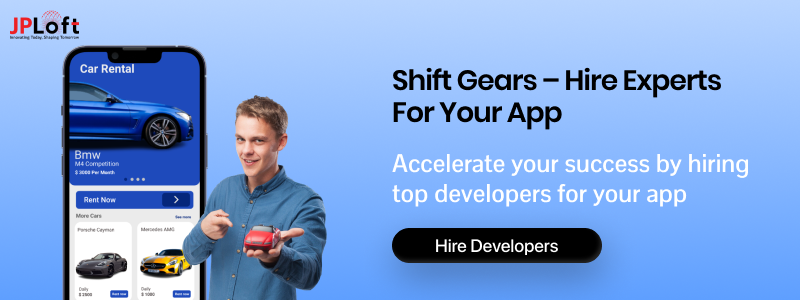
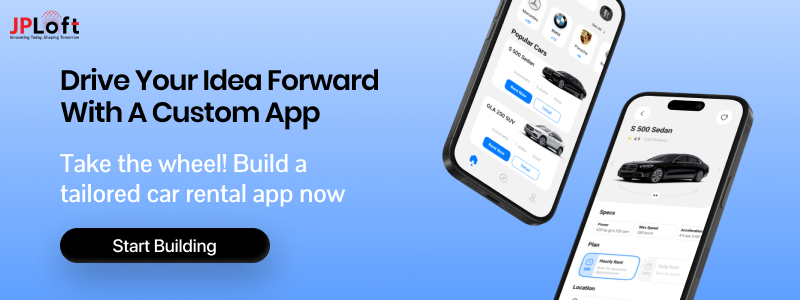
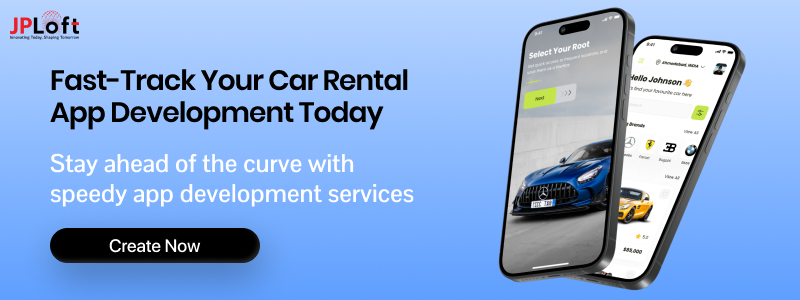

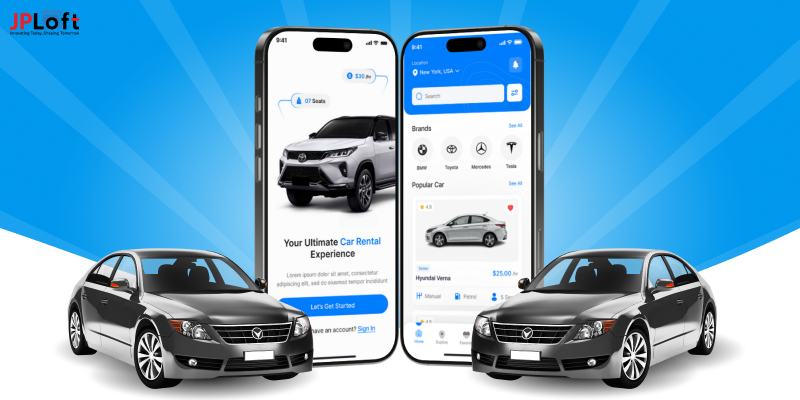
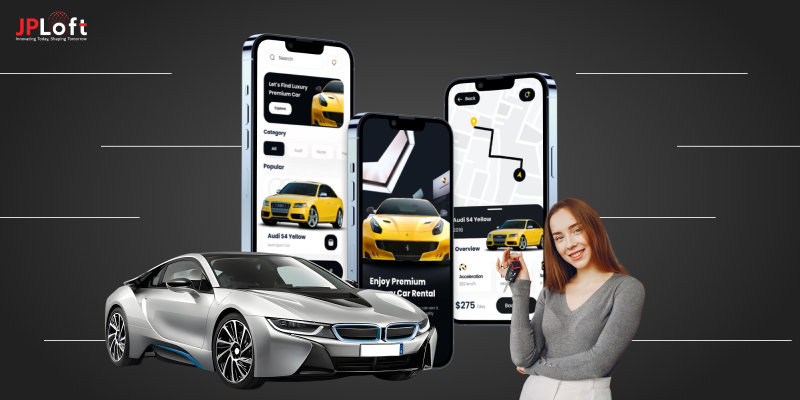
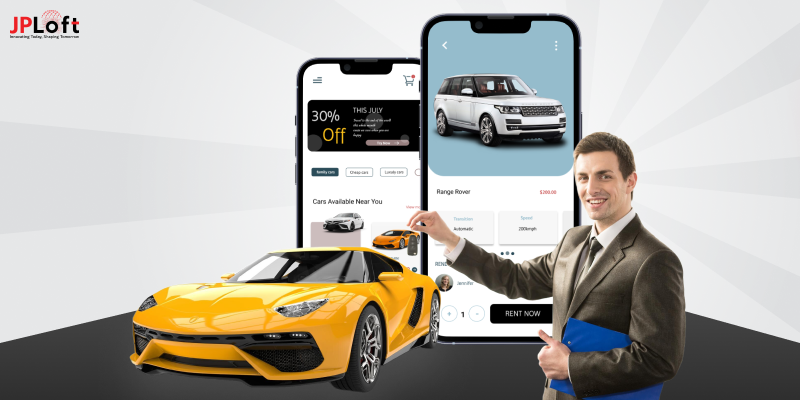



Share this blog